The world of nonprofit fundraising is more competitive than ever before. Behind each essential cause and community in need are worthy nonprofits raising money on their behalf.
This competitive landscape doesn’t mean your organization should throw in the towel—instead, it’s time to get creative and optimize your efforts. Through this guide, we’re going to explore how nonprofits can utilize data-driven marketing tactics to increase donations through direct marketing campaigns.
This guide will explore the following topics:
- What Is Nonprofit Direct Marketing?
- Benefits of Nonprofit Direct Marketing
- Types of Direct Marketing for Nonprofits
- Key Direct Marketing Statistics and Benchmarks
- Direct Marketing for Nonprofits: Best Practices
Let’s begin with a brief overview of nonprofit direct marketing before exploring how your organization can make the most of its efforts.

What Is Nonprofit Direct Marketing?
Nonprofit direct marketing refers to campaigns in which you send communications directly to donors and supporters.
This is a push marketing tactic, an effort that involves interacting directly with the donor, as opposed to pull marketing tactics, in which supporters are drawn to your organization by the general messaging surrounding it.
Benefits of Nonprofit Direct Marketing
When you communicate with your supporters and promote your organization through direct marketing, your nonprofit will experience a variety of benefits. Nonprofit direct marketing strengthens your outreach efforts by:
- Enabling personalization. When you use direct marketing, you can target specific segments of your audience based on characteristics such as age, location, and involvement with your organization. This level of personalization allows you to connect with your supporters and build deeper relationships with them.
- Increasing engagement. 78% of marketers claim that segmentation is the most effective strategy for email campaigns. Speaking directly to different audience segments and their interests allows you to increase engagement for your communications. As a result, you’re more likely to accomplish your marketing goals—whether that’s encouraging donations, recruiting volunteers, or simply raising awareness for your cause.
- Preserving resources. Nonprofit direct marketing involves pinpointing the right messages and sending them to the right people. As opposed to mass communications that target everyone in your database, direct marketing allows you to preserve resources for the supporters who are most interested in each campaign.
- Producing measurable results. After your direct marketing campaign is over, you can analyze the resulting key performance indicators (KPIs)—such as response rates, click-through rates, and conversion rates—and apply the insights you gather to your future campaigns.
Overall, nonprofit direct marketing is a win-win situation. Your supporters receive more relevant, personalized communications that inspire them to take action, and your nonprofit increases engagement and preserves resources as a result.
Types of Direct Marketing for Nonprofits
Now that you have a better understanding of what direct marketing is and why it’s so beneficial, let’s review five of the most popular types of direct marketing for nonprofits: email, direct mail, social media advertising, programmatic advertising, and connected TV advertising.
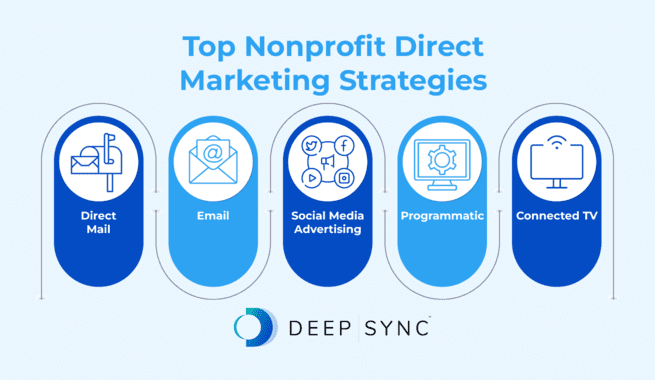
Email Marketing
If you’ve ever signed up for an email list or checked “Yes” when asked if you’re open to receiving future communications and offers, you’ve likely been the recipient of direct email marketing.
For-profit businesses (especially those that sell products and services online), nonprofits, churches, clubs, and many other types of organizations all utilize email marketing in their overall strategies. For now, let’s focus on nonprofit direct email marketing and the different forms it may take.
Newsletters
Newsletters are generally longer email communications, with the main goal of sharing information (“news”) about your organization and its efforts. Many nonprofits send these on a recurring basis, such as monthly or every other week, to keep supporters in the loop about current and upcoming initiatives.
These communications typically contain information such as organization updates, short stories, testimonials, educational content, and even calls to action.
However, while newsletters are generally longer than the other email communications we’re going to discuss, your nonprofit can’t just feature long blocks of text and be successful. Instead, you should also include images, subheadings, and links to outside sources (such as blog posts) to provide more context to your newsletter without overwhelming busy supporters.
Appeals
With email appeals, you can inspire donors to give to your organization. While you may be tempted to rope email appeals in with the overall umbrella of fundraising-related communications, remember that there are a few key aspects that make this type of communication unique.
For starters, we know that on average, people spend just 9 seconds viewing an email after opening it. This statistic illustrates that email appeals need to be significantly shorter than their direct mail counterparts.
Additionally, email appeals are often more focused on taking action than other communications. They point to specific calls to action (typically to contribute a monetary donation), demonstrate the action’s intended purpose or impact, and may even provide suggested donation amounts.
Advocacy
Advocacy communications invite supporters to participate in larger advocacy campaigns by giving their time, efforts, and attention to your cause. Advocacy campaigns often include many ways to get involved, such as volunteering, contacting representatives, signing petitions, and other ways of spreading awareness about a cause.
Because there is inherently more information to convey in these communications, include links to advocacy opportunities on your website. That way, you can keep supporters engaged and encourage them to explore additional resources from your nonprofit while still writing a concise email.
Direct Mail
Direct mail marketing refers to sending physical mailings to supporters via the postal service. While many nonprofits focus primarily on digital communications, direct mail remains a valuable resource for nonprofits, with an average response rate of 5.3%.
Although the costs of direct mail are typically higher than those of online channels (and continue to rise as postal rates increase), the high return on investment (ROI) and increased engagement levels are well worth it.
There are two main types of direct mail campaigns: housefile campaigns and prospecting campaigns.
Housefile Campaigns
Housefile campaigns occur when you mail information to supporters already in your database. This includes donors, volunteers, and mailing list subscribers.
This type of campaign is often the first step for nonprofits incorporating direct mail into their marketing strategies, as it has a higher chance of success than prospecting efforts. Then, once you have the resources to continue with direct mail, you may turn to prospecting campaigns.
Prospecting Campaigns
Prospecting campaigns involve sending mail to prospective supporters who have no pre-established connection to your organization. The goal of this type of campaign is to connect with those who are most likely to support your organization, inform them of giving opportunities, and inspire them to contribute.
Supporters you recruit through these campaigns become a part of your nonprofit’s housefile. To successfully identify prospects who are likely to convert, consider working with a data provider that can help you discover and narrow down your list of prospective households based on your target audience’s characteristics.
Social Media Advertising
Another popular form of nonprofit direct marketing is paid social media ads. While this method was previously reserved for for-profit businesses, nonprofits are increasingly using social media advertising to reach their supporters, spread awareness, and fundraise.
Depending on your audience’s demographics, you may use different combinations of social media platforms for your advertising efforts. For example, a nonprofit with many Gen Z supporters may opt to run ad campaigns on Instagram and TikTok, whereas an organization with a mostly Millennial audience may choose to prioritize Facebook advertising.
Programmatic
Programmatic advertising is the use of automated technology to buy and sell digital ad space. By using artificial intelligence (AI) and algorithms to streamline the ad-buying process, your nonprofit can efficiently run data-driven ad campaigns through display, video, social media, and more.
This type of nonprofit direct marketing campaign serves as an alternative to manual ad placements, allowing nonprofits to save time and resources. Additionally, programmatic advertising enables you to target specific audiences based on their demographics, interests, and online behavior. As a result of the small time investment and highly targeted ads you’ll produce from this tactic, you’ll also experience a high ROI.
Connected TV
These days, many TVs are connected to the internet, allowing people to stream their favorite shows, movies, music, and video games. Connected TV (CTV) advertising takes advantage of this trend by delivering targeted ads through internet-connected TV sets.
While traditional TV ads are a form of mass media only tailored to the channel you’re watching and the location you’re watching from, CTV ads are personalized to viewers’ habits, interests, and demographics. That way, your nonprofit can run CTV advertising campaigns that reach your target audience and inspire those who are most likely to support your organization to take action.
Key Direct Marketing Statistics and Benchmarks
Some nonprofit professionals extoll the values of pull marketing tactics—such as building relationships with supporters and having a general presence in your community—as the ultimate way to generate support for your nonprofit. We’re not going to argue against the value of these efforts—they’re incredibly beneficial and crucial for long-term success and capacity building!
However, that doesn’t mean you should neglect the power of nonprofit direct marketing tactics. Check out these direct marketing statistics that demonstrate the immense impact of these campaigns:
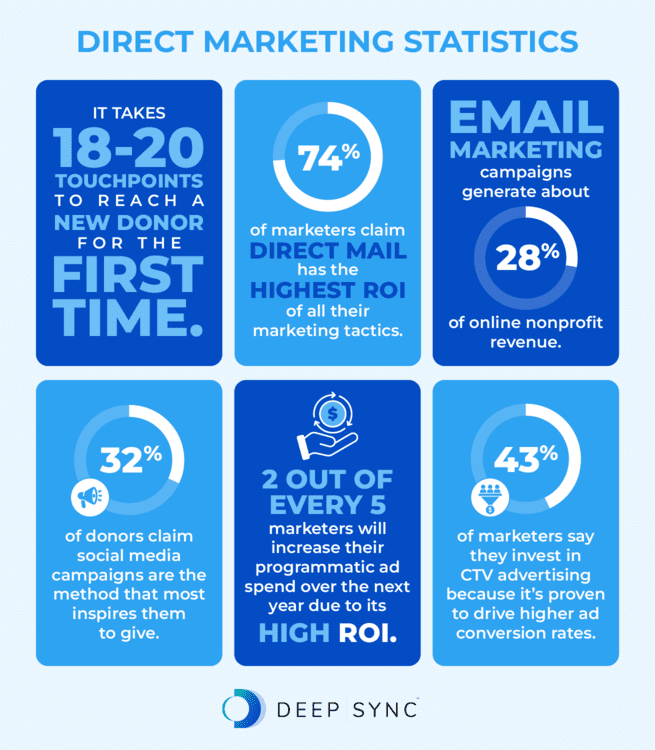
- It can take 18-20 points of contact to reach a new donor for the first time.
- 48% of donors claim regular email communications are most likely to keep them engaged and encourage them to donate again in the future.
- Email marketing campaigns generate about 28% of online nonprofit revenue.
- Nonprofits raise an average of $90 per 1,000 fundraising emails sent.
- After receiving direct mail, 47% of Millennials visited the sending organization’s website.
- 74% of marketers claim direct mail has the highest ROI of all their marketing tactics.
- 32% of donors claim social media campaigns are the method that most inspires them to give.
- 2 out of every 5 marketers will increase their programmatic ad spend over the next year due to its high ROI.
- 88% of households in the United States have at least one connected TV device.
- 43% of marketers say they invest in CTV advertising because it’s proven to drive higher ad conversion rates.
These statistics demonstrate that by combining different direct marketing tactics—such as email, direct mail, social media, programmatic, and CTV advertising—you can reach your target audience on their preferred platforms and push your marketing and fundraising goals forward. However, it’s up to your organization to create a strong direct marketing strategy and measure success along the way.
With that in mind, here are a few benchmarks that you can use to assess the success of your campaign:
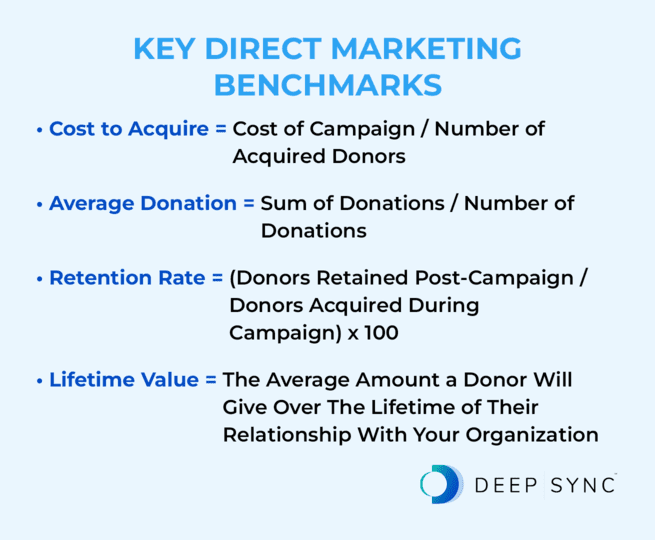
- The cost to acquire each donor.
- The average donation amount across donors.
- The retention rate of acquired donors.
- The lifetime value of a donor.
According to Fundraising Report Card, there are a few key metrics trends to look out for when conducting a direct marketing campaign. For example, the cost to acquire a donor should be lower than the average lifetime value of the donors you’re acquiring. Additionally, compare the lifetime value of the donors you’ve acquired through different direct marketing channels to determine which are most effective for your nonprofit.
Direct Marketing for Nonprofits: Best Practices
By now, you’ve seen just how effective nonprofit direct marketing can be. However, these campaigns can be more expensive than other methods due to their personalization and channel-specific costs, such as printing and postage for direct mail.
That doesn’t mean your organization should abandon or neglect to adopt direct marketing, though. It just means that it’s essential to develop a strong direct marketing strategy to maximize your ROI.
With that in mind, let’s go over a few tips to help your organization create a successful nonprofit direct marketing strategy.
Our Top Tip: Work With a Data Provider
Our top tip is to work with a data provider that can help you formulate your nonprofit direct marketing strategy and power your campaigns with complete, accurate supporter data.
Before you even begin sending communications, you have to discover the right audience for your direct marketing campaign. The best way to go about this is to work with a data provider that can:
- Provide a full suite of targeted data solutions. This includes data hygiene and data enhancement to ensure you’re building your campaign based on accurate information.
- Conduct wealth screening and fundraising analytics. These services help your organization discover supporters within your database and the greater community that have the highest capacity and affinity to give.
- Help you build and activate an audience across online and offline channels. The best data providers will help you push your campaigns forward through custom audience creation. Access different datasets and combine different data segments so you can reach the exact target audience you’re looking for. Then, your provider will help you launch your campaign across a variety of direct marketing channels.
With the help of a data provider, you’ll be able to create data-driven direct marketing campaigns that generate a high ROI.
Additional Direct Marketing Best Practices
Beyond working with a direct marketing agency to find your audience and formulate your campaign, there are a variety of other ways you can fortify your direct marketing campaigns, including:
- Enable A/B testing and experimentation. For example, you may vary the subject line and level of personalization in emails and test which options have the highest engagement rate. Or, vary the inserts, letter length, and even paperweight of physical mailings.
- Use a multi-channel marketing approach. As we’ve seen, a campaign that utilizes multiple channels for communications—such as email, direct mail, and social media—is more successful than a campaign that uses just one since it creates multiple touchpoints for supporters to interact with your organization.
- Prioritize writing a compelling appeal. Remember that the ideal audience and perfectly targeted communications can’t outrun a subpar appeal. Put effort into crafting the ideal messaging and visuals to ensure supporters are inspired to give.
- Honor your donors’ requests. You may encounter supporters who are on “Do Not Mail” lists or who have opted out of your email lists. Respect these preferences, as it’s much better for your organization’s reputation to exclude a supporter from a campaign than send them unwanted communications.
With these tips, you’ll create direct marketing campaigns that not only target prospects likely to give but also engage those supporters. You’ll grow your supporter base and reinvigorate existing support at the same time!
Direct marketing is a time-proven, effective method for finding new donors, stewarding current donors, and raising more for your organization in the long run. Whether you’re conducting direct mail, email, social media, programmatic, CTV, or (even better) a combination of these methods, you’re sure to find success in spreading the word about your mission.
For more data marketing tips, check out the following additional resources:
- Data-Driven Digital Marketing Strategies for Enhanced Targeting. Explore Deep Sync’s data-driven digital marketing strategies that your nonprofit can leverage to better reach your target audience.
- Data Hygiene: How to Make Your Data Accurate and Actionable. To make the most of your data, you must first cleanse it. Check out this guide to data hygiene to clean up your data and maintain high data quality in the long run.
- Data-Driven Marketing: A Comprehensive Guide to Success. Explore data marketing and overall best practices for your efforts through this guide.
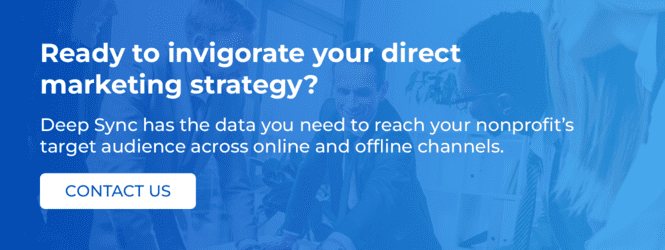











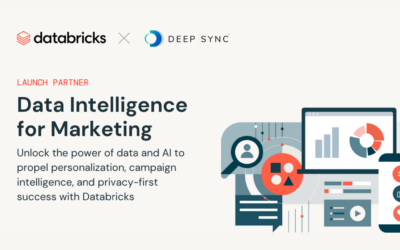
0 Comments